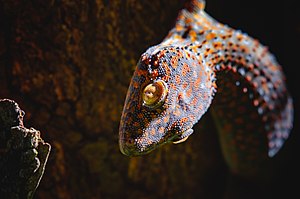Tokecang Island Gecko: Difference between revisions
| Line 46: | Line 46: | ||
==Behaviour== | ==Behaviour== | ||
The Tokecang Island gecko is generally shy and docile. When cornered, it can inflict a stronger bite than the tokay due to its stronger jaws and will often cause bleeding to [[Human (Realms)|humans]] and small animals. Females lay clutches of one | The Tokecang Island gecko is generally shy and docile. When cornered, it can inflict a stronger bite than the tokay due to its stronger jaws and will often cause bleeding to [[Human (Realms)|humans]] and small animals. Females lay clutches of one hard-shelled egg (or, in rarer cases, two) and guard them until they hatch. | ||
===Diet=== | ===Diet=== | ||
Revision as of 09:32, 30 November 2023
This article is incomplete because it is pending further input from participants, or it is a work-in-progress by one author. Please comment on this article's talk page to share your input, comments and questions. Note: To contribute to this article, you may need to seek help from the author(s) of this page. |
| Tokecang Island Gecko | |
|---|---|

| |
| Scientific classification | |
| Kingdom: | |
| Phylum: | |
| Class: | |
| Order: | |
| Family: | |
| Genus: | |
| Species: | G. tokecangensis
|
| Binomial name | |
| Gekko tokecangensis Roesli, 1963
| |
The Tokecang Island Gecko, also known as the nut-eating gecko for its peculiar diet, is a nocturnal, arboreal species of gecko found in its namesake island in West Java, Nusantara, Amenria.
Etymology
"Tokecang" is a Sundanese nonsense word from a local nursery rhyme of the same title.
"Tokek" is an onomatopoeia of the mating call made by the males of the species.
Distribution and habitat
The Tokecang Island gecko is only found on Tokecang Island in the wild. Due to the relative ease of finding food for it, they became increasingly popular pets until the government of Indonesia heavily restricted its export in 2016 before completely banning its trade in 2023.
Due to its export, the Tokecang Island gecko is considered an introduced species in places where escaped specimen have been found, from other islands in Nusantara, Indochina, and Bharata to as far away as Florida.
Physical characteristics
The Tokecang Island gecko is the largest known gecko species at an average length of 30-35 cm and the largest specimens reaching up to 50 cm, larger than even the New Caledonian giant gecko. It is cylindrical, but somewhat flattened in body shape. The eyes have vertical pupils.
The skin is soft to the touch, and while it can change its colour to match its surroundings, it is normally blue-gray with red or orange spots and speckles. Unlike its closest relative the tokay gecko, it is not dimorphic, with both genders sharing the same tones of colour. Like the tokay gecko, however, it has foot pads that can support its entire weight on vertical surfaces for an extended period of time, a semiprehensile tail, and a large head. It has stronger jaws than the tokay, which allows it to crack softer nutshells.
Behaviour
The Tokecang Island gecko is generally shy and docile. When cornered, it can inflict a stronger bite than the tokay due to its stronger jaws and will often cause bleeding to humans and small animals. Females lay clutches of one hard-shelled egg (or, in rarer cases, two) and guard them until they hatch.
Diet
The Tokecang Island gecko is the only know herbivorous gecko in the world and several universes, being absent in many such as R44 and R50 for unknown reasons.